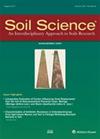亚热带地区蔬菜集约种植导致土壤严重退化:以中国西南地区为例
4区 农林科学
Q2 Agricultural and Biological Sciences
引用次数: 3
摘要
摘要在可持续发展的背景下,土地利用变化导致的土壤退化被认为是一个严重的全球性问题,但从种植谷物到种植蔬菜的转变受到的关注有限,特别是在亚热带地区。本研究基于面对面农户调查和土壤分析,研究了中国西南水稻轮作油菜轮作蔬菜对土壤有机碳(SOC)、全氮(TN)、C/N、pH、磷(P)、钾(K)、钙(Ca)和镁(Mg)的影响。在蔬菜种植系统中,肥料施用通常超过作物需求量或当地推广服务建议的水平数倍以上。因此,氮、磷、钾、钙、镁的作物利用效率分别只有26%、8%、56%、23%和28%。在研究的蔬菜种植系统中,由于作物残茬有机投入少和耕作频率高,土壤有机碳储量、全氮储量和氮储量显著减少。土壤碳氮比略有下降;每增加100 kg ha - 1磷肥,表层土壤速效磷(AP)增加1.92 mg kg - 1,磷淋溶中AP和钙溶性磷的临界水平分别为104和0.80 mg P kg - 1。此外,与目前的水田-旱作系统相比,菜田土壤酸化趋势明显。增加土壤Ca和mg含量显著缓解了表层土壤酸化,且随时间的增加效果逐渐增强。基于我们的研究结果,本文讨论了保护性农业实践、土壤-作物系统综合管理策略和农业技术服务对恢复退化土壤和提高蔬菜生产力的潜在效益。本文章由计算机程序翻译,如有差异,请以英文原文为准。
Significant soil degradation is associated with intensive vegetable cropping in a subtropical area: a case study in southwestern China
Abstract. Within the context of sustainable development, soil degradation driven by land use change is considered a serious global problem, but the conversion from growing cereals to vegetables is a change that has received limited attention, especially in subtropical regions. Here, we studied the effects of the conversion from paddy rice to an oilseed rape rotation to vegetable production in southwestern China on soil organic carbon (SOC), total
nitrogen (TN), the C/N ratio, pH, phosphorus (P), potassium (K), calcium (Ca), and magnesium (Mg) based on face-to-face farmer surveys and soil analysis. In the vegetable cropping system, fertilizer application often exceeds the crop demand or levels recommended by the local extension service several times over. Thus, the crop use efficiency of N, P, K, Ca, and Mg was only 26 %, 8 %, 56 %, 23 %, and 28 %, respectively. In the vegetable cropping system studied, SOC, C stock, TN, and N stock were decreased significantly due to low organic inputs from crop residues and high tillage frequency. Furthermore, the soil C/N ratio decreased slightly; available P (AP) in the topsoil increased by 1.92 mg kg−1 for every 100 kg ha−1 of P surplus, and
the critical levels of AP and CaCl2-soluble P in P leaching were 104
and 0.80 mg P kg−1. Besides, compared to the current paddy–rape
rotation system, a clear trend of soil acidification was observed in the
vegetable fields. However, increasing the contents of soil Ca and Mg
significantly alleviated topsoil acidification, with the effect increasing
over time. Given our findings, the potential benefits of conservation
agricultural practices, integrated soil–crop system management strategies,
and agricultural technology services for recovering the degraded soil and
improving the vegetable productivity are discussed here.
求助全文
通过发布文献求助,成功后即可免费获取论文全文。
去求助
来源期刊

Soil Science
农林科学-土壤科学
CiteScore
2.70
自引率
0.00%
发文量
0
审稿时长
4.4 months
期刊介绍:
Cessation.Soil Science satisfies the professional needs of all scientists and laboratory personnel involved in soil and plant research by publishing primary research reports and critical reviews of basic and applied soil science, especially as it relates to soil and plant studies and general environmental soil science.
Each month, Soil Science presents authoritative research articles from an impressive array of discipline: soil chemistry and biochemistry, physics, fertility and nutrition, soil genesis and morphology, soil microbiology and mineralogy. Of immediate relevance to soil scientists-both industrial and academic-this unique publication also has long-range value for agronomists and environmental scientists.
 求助内容:
求助内容: 应助结果提醒方式:
应助结果提醒方式:


